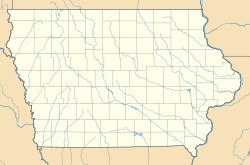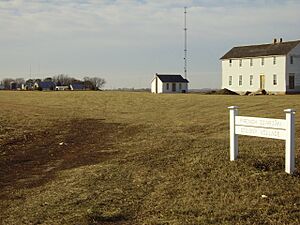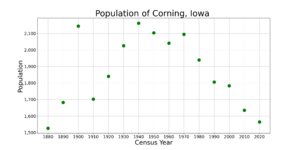Corning, Iowa facts for kids
Quick facts for kids
Corning, Iowa
|
|
|---|---|
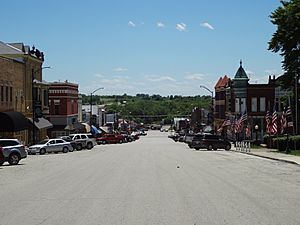
View of Main Street in Corning
|
|
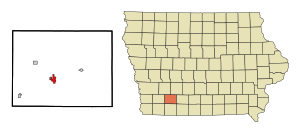 |
|
| Country | |
| State | |
| County | Adams |
| Township | Quincy |
| Area | |
| • Total | 1.56 sq mi (4.05 km2) |
| • Land | 1.56 sq mi (4.04 km2) |
| • Water | 0.01 sq mi (0.01 km2) |
| Elevation | 1,217 ft (371 m) |
| Population
(2020)
|
|
| • Total | 1,564 |
| • Density | 1,003.85/sq mi (387.54/km2) |
| Time zone | UTC-6 (Central (CST)) |
| • Summer (DST) | UTC-5 (CDT) |
| ZIP code |
50841
|
| Area code(s) | 641 |
| FIPS code | 19-16500 |
| GNIS feature ID | 2393636 |
| Website | http://www.cityofcorningia.com/ |
Corning is a city in Adams County, Iowa, United States. It is the main town, also known as the county seat, for Adams County. In 2020, about 1,564 people lived there.
Corning is located just north of where two important roads meet: U.S. Route 34 and Iowa Highway 148. The city is famous as the birthplace of Johnny Carson, a well-known American TV host. Another famous person from Corning is Daniel Webster Turner, who was the governor of Iowa from 1931 to 1933.
The town got its name from Erastus Corning. He owned shares in the Burlington and Missouri River Railroad. When the railroad reached Corning on August 23, 1869, the local train station moved here. Erastus Corning also gave a church bell to the Methodist Church in town.
Contents
Fun Things to Do in Corning
Outdoor Adventures
Adams County, where Corning is located, has many fun outdoor activities. You can go fishing and boating at Lake Icaria. There are also places to hike and camp in the parks. The area's natural beauty makes it a great spot for anyone who loves the outdoors.
If you like car races, check out the Adams County Speedway. It's a popular dirt track in Corning. Many racing fans come here to watch exciting auto racing events.
Historic Downtown
Downtown Corning has many old and beautiful buildings. Some of these buildings are even listed on the National Register of Historic Places. They show off the town's rich history and make the area look special.
Local Shops and Food
The downtown area also has many local shops and restaurants. You can find unique things to buy and delicious food to eat. Many businesses use products from nearby farms and areas. This helps the community feel connected.
Arts and Culture
Corning's downtown is also home to the Corning Opera House. This theater hosts many shows and events all year long. It's a great place to see local talent and enjoy the arts.
Community Events
The downtown area is a busy spot for community events. These include farmers' markets, seasonal festivals, parades, and holiday parties. These events bring people from Corning and nearby areas together. They help create a strong sense of community.
Corning's Story
French Icarian Settlement
The first European settlers in this area were a group of French Icarians. They came from Illinois in 1852. In 1854, they started a community near Lake Icaria, north of Corning. This town, called "Icaria," received its official charter in 1860.
The Icarians believed in the ideas of Etienne Cabet. They also believed in the democratic ideas of the American Revolution and the French Revolution. This small French-speaking group saw themselves as very patriotic Americans. In the 1860s, the community had a disagreement. Some wanted to keep old traditions, while others, called "progressives," wanted new ideas like women's right to vote. The "progressives" moved to a new spot a few miles east of Corning.
Even though the community officially ended in 1878, some people continued to live in the shared homes until 1898. This made it the longest-lasting Icarian colony in the United States. Eventually, the community broke up, and its members joined the general population. You can learn more about the Icarians at the Icarian History Foundation office in Corning. The old colony east of Corning is slowly being fixed up to become a historical site. Around the first weekend of June each year, Corning celebrates "Le Festival De L'Heritage Francais" (The French Heritage Festival).
American Settlement
A nearby town called Queen City was started around 1854. Surveyors came to the area where Corning is now in 1857. But not many people lived there (except the Icarians) until 1869.
The first county seat of Adams County was in Quincy in 1853. The building was later used as a school. In November 1872, people voted to move the county seat to Corning.
Places to See
The Corning post office has a special painting called Band Concert. Marion Gilmore painted it in 1941. This painting was part of a program to create art in public buildings across the United States. Gilmore's original idea for the painting won a competition. However, local citizens asked her to change it to show only real buildings and landmarks from downtown Corning. She made the changes to fit the town's wishes.
In 1996, Main Street Corning won the Spirit of Main Street Award. In 1998, it received the Great American Main Street Award. These awards are for towns that work hard to improve their downtown areas. Volunteers have spent many hours helping Main Street Corning since 1990.
You can also visit the birthplace of Johnny Carson. The Johnny Carson board has fixed up his childhood home to look like it did when he was born. It is now a museum that visitors can explore.
Festivals
Corning hosts the Lazy Days of Summer festival on the last weekend of July. This fun weekend includes a BBQ cooking competition, a street dance, a Doctors' Dash race, and other events around the community.
Parks and Recreation
Lake Icaria is a large, man-made lake about four miles north of Corning. It covers 650 acres. The lake has a beach, a marina for boats, playgrounds, and picnic areas. You can also find cabins and campgrounds there. Lake Icaria is great for fishing, with many types of fish like bass and catfish. Boating and camping are very popular, bringing visitors from all over Iowa, Missouri, and Nebraska.
A smaller lake, Lake Binder, is one mile east of Corning. It's a quieter place for camping and fishing.
The Nodaway River has two smaller rivers that flow through the area. The East Nodaway River goes through Corning. The Middle Nodaway River runs four miles north of town. Both rivers are popular for kayaking and tubing in the summer.
Sports
Corning is home to the Adams County Speedway. Car races are held here on Saturday nights from April through September. The speedway is part of the Whelen All-American Series. It features different types of race cars, including Late Models and Modifieds.
Corning also has the Carnac Family Skatepark. This skatepark is about 1,200 square feet. It was built with money donated by people who cared about the community. Major donations came from Corning native Johnny Carson ($75,000) and famous skateboarder Tony Hawk ($5,000).
Geography
Corning covers about 1.58 square miles (4.05 square kilometers) of land.
Climate
Corning has a climate with hot summers. This means it gets warm and humid in the summer months.
Population History
| Historical population | ||
|---|---|---|
| Year | Pop. | ±% |
| 1880 | 1,526 | — |
| 1890 | 1,682 | +10.2% |
| 1900 | 2,145 | +27.5% |
| 1910 | 1,702 | −20.7% |
| 1920 | 1,840 | +8.1% |
| 1930 | 2,026 | +10.1% |
| 1940 | 2,162 | +6.7% |
| 1950 | 2,104 | −2.7% |
| 1960 | 2,041 | −3.0% |
| 1970 | 2,095 | +2.6% |
| 1980 | 1,939 | −7.4% |
| 1990 | 1,806 | −6.9% |
| 2000 | 1,783 | −1.3% |
| 2010 | 1,635 | −8.3% |
| 2020 | 1,564 | −4.3% |
| Source: Source: |
||
Who Lives in Corning?
In 2020, there were 1,564 people living in Corning. Most of the people living in Corning are White. A small number of people are Black, Native American, or Asian. Some people are also from two or more races. About 1% of the population is Hispanic or Latino.
The average age of people in Corning in 2020 was about 43.9 years old. About 23.7% of the residents were under 20 years old. About 23% were 65 years old or older. Slightly more than half of the residents were female (52.9%), and a bit less than half were male (47.1%).
Education
Students in Corning go to public schools run by the Corning Community Schools district. Since 2013, this district has worked with the nearby Villisca Community School District. Together, they operate Southwest Valley High School. The mascot for Southwest Valley High School is the Timberwolf. Before this, students graduated from Corning High School, and their mascot was the Red Raiders.
Famous People from Corning
- Byron Barr, an actor who appeared in movies like Double Indemnity.
- Johnny Carson, a famous American talk show host and comedian.
- Horace Mann Towner, a U.S. Representative who later became the Governor of Puerto Rico.
- Daniel Webster Turner, who served as the Governor of Iowa.
Images for kids
See also
 In Spanish: Corning (Iowa) para niños
In Spanish: Corning (Iowa) para niños


